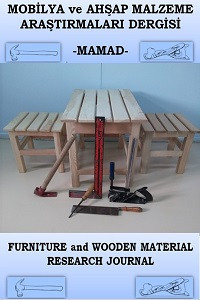CNC makineleri ile işlenen lif levhaların yüzey pürüzlülüğü üzerine bıçak adımı, besleme hızı ve kesme derinliğinin etkileri
Lif levha tüm dünyada mobilya üretiminde büyük miktarlarda kullanılmaktadır. Lif levhanın tercih edilmesinin en önemli nedenlerinden biri yüzeyinin kolay şekillendirilmesidir. Geçmişte, Lif levhaların yüzeyleri konvansiyonel makinelerle işlenmiştir. Günümüzde, Bilgisayar Sayısal Kontrol (CNC) makineleri lif levhaların işlenmesinde kullanılmaktadır. CNC makineleri, makinenin hareketini sağlayan bilgisayar kontrol komutları kullanılarak çalıştırılmaktadır. Bu komutlardan oluşan kod dosyaları, bıçak adımı, bıçak motoru hızı, besleme hızı, kesme derinliği, işleme taktiği, bıçak dalma derinliği, dalma hızı gibi birçok ayarlamaları içermektedir. Bu ayarlamalar, lif levhanın işlenen kısmının yüzey pürüzlülüğünü değiştirmektedir. Bu çalışmada, kesme derinliği, (2 mm ve 6 mm) bıçak adımı (%40, %60 ve %80) ve besleme hızı (3, 5 ve 7 m/min) ayarlarının lif levhanın yüzey pürüzlülüğü üzerine etkileri araştırılmıştır. Lif levha test örneklerinin işlenen kısımlarının Ra pürüzlülük değeri iğne taramaları temas yöntemi kullanılarak belirlenmiştir. Elde edilen verilere göre; kesme derinliği, besleme hızı ve bıçak adımı arttıkça yüzey pürüzlüğünün arttığı belirlenmiştir.
Anahtar Kelimeler:
CNC makineleri, yüzey pürüzlülüğü, bıçak adımı
The effects of step over, feed rate and finish depth on the surface roughness of fiberboard processed with CNC machine
Fiberboard is used extensively in furniture production in all over the word. One of the most important reasons for the preference of fibreboard is the easy shaping of its surfaces. In the past, the surfaces of the fiberboard were processed using conventional machines. Nowadays, Computer Numerical Control (CNC) machines are used in the processing of the fiberboard. CNC machines is operated using some computer control commands which provide the action of the machine. The code file consisting of these commands contains some adjustments such as step over, spindle speed, feed rate, finish depth, machining strategy, step down, plunge rate etc. These adjustments change the surface roughness of the processed section of fiberboard. In this study, the influence of finish depth (2 and 6 mm), step over (40%, 60% and 80%) and feed rate (3, 5 and 7 m/min) settings on the surface roughness of fiberboard were investigated. Ra roughness value of processed section of fiberboard test samples was determined using contact stylus method. According to the obtained data, it was concluded that the surface roughness increased as finish depth, feed rate and step over are increased.
Keywords:
CNC machines surface roughness, step over, feed rate,
___
- Bal, B.C., and Bektaş, İ, (2018), Determination of relationship between density and some physical properties in beech and poplar wood, Furniture and Wooden Material Research Journal, 1(1), 1-10.
- Bal, B.C.,(2018), The effects of some tool paths adjustments of CNC machines on surface roughness and processing time of fiberboards, Furniture and Wooden Material Research Journal, 1(1), 21-30.
- Bektaş, İ.(1997), Kızılçam odununun teknolojik özellikleri ve yörelere göre değişimi, İÜ, Fen Bilimleri Enstitüsü, Doktora Tezi, İstanbul.
- Benardos, P.G., and Vosniakos, G. C., (2003), Predicting surface roughness in machining: a review, International Journal of Machine Tools And Manufacture, 43(8), 833-844.
- Bozkurt, Y., ve Göker, Y. (1996), Fiziksel ve mekanik ağaç teknolojisi, Yılmaz Bozkurt, Yener Göker İÜ, Orman Fakültesi Yayınları, No:3944, İstanbul.
- Davis, E.M., (1962), Machining and related characteristics of United States hardwoods, Technical Bulletin No: 1267, US Department of Agriculture Forest Service.
- De Deus, P. R., de Sampaio Alves, M. C., and Vieira, F. H.A. (2015), The quality of MDF work pieces machined in CNC milling machine in cutting speeds, feed rate, and depth of cut, Meccanica, 50 (12), 2899-2906.
- Erer, H., (2000), CNC takım tezgâhlarının gelişimi, http://www.turkcadcam.net/rapor/cnc-ttg/index.html, son erişim tarihi: 18.06.2018.
- Karagöz, Ü., (2011), CNC ile işlemede ahşap malzemenin yüzey kalitesini etkileyen faktörler, Kastamonu Üniversitesi Orman Fakültesi Dergisi, 11(1), 18-26.
- Kollmann, F., and Cote, W.A. (1968), Principles of wood science and technology. Springer Verlag.
- Lin, R.J.T., Houts, J.V., Bhattacharyya, D., (2006), Machinability investigation of medium density fiberboard, Holzforschung, 60(1), 71-77.
- Lou, M. S., Chen, J. C., and Li, C. M., (1998), Surface roughness prediction technique for CNC end-milling, Journal of Industrial Technology, 15(1), 1-6.
- Sedlecký, M., (2017), Surface roughness of medium-density fiberboard (MDF) and edge-glued panel (EGP) after edge milling, BioResources, 12(4), 8119-8133.
- Sedlecký, M., Kvietková, M. S., and Kminiak, R. (2018), Medium-density fiberboard (MDF) and edge-glued panels (EGP) after edge milling-surface roughness after machining with different parameters. BioResources, 13(1), 2005-2021.
- Sofuoglu, S.D. (2015), Determination of Optimal machining parameters of massive wooden edge-glued panels made of European larch (Larix decidua Mill.) using Taguchi Design Method, BioResources, 10(4), 7772-7781.
- Sütçü, A., and Karagöz, Ü. (2012), Effect of machining parameters on surface quality after face milling of MDF, Wood Research, 57(2), 231-240.
- Sütçü, A., and Karagöz, Ü. (2013), The influence of process parameters on the surface roughness in aesthetic machining of wooden edge-glued panels (EGPs), BioResources, 8(4), 5435-5448.
- TS 971, Surface roughness-parameters, their values and general rules for specifying requirements, TSE, Ankara, 1999.
- Yayın Aralığı: Yılda 2 Sayı
- Başlangıç: 2018
- Yayıncı: Bekir Cihad BAL
Sayıdaki Diğer Makaleler
Yonga levha üretiminde pirinç kavuzu kullanımının yüzey pürüzlülüğü üzerine etkisi
Fatih ŞAHİN, Emre BİRİNCİ, Alperen KAYMAKCI
Manolya ağacı, akçaağaç ve tespih ağacı odunlarında vida tutma direnci üzerine bir araştırma
Odunun yoğunluğu ile mekanik özellikleri arasındaki ilişkinin belirlenmesi üzerine bir araştırma
Bekir Cihad BAL, İbrahim BEKTAŞ
Ahşap ve mimarlık eğitimi: İstanbul örneği
Mobilya endüstrisi atıklarının polimer kompozit üretiminde değerlendirilmesi
Nasır NARLIOĞLU, Tufan SALAN, Nihat Sami ÇETİN, Mehmet Hakkı ALMA
